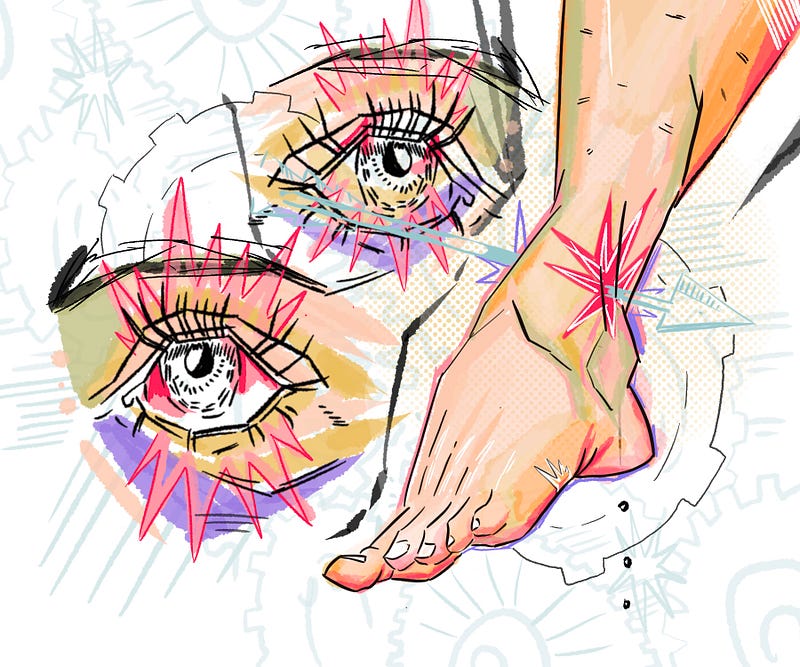Hidden in Plain Sight

My experience with arthritis and how it changed my view of others with chronic illnesses.
Story by Aedan Scanlon
I n pain at the age of 2, we didn’t even know what I had. I’m not sure I can even describe the pain, because at that point my life had just begun. This was the start of my hidden disability.
Abnormalities were first discovered by my mom at a family friend’s house. The room was bright and then the lights got turned off to watch a movie. My mom noticed that my pupils weren’t the same size as each other. She immediately took me to the doctor, because she thought I had head trauma.
After checking my eyes, the doctor told my mom that there was inflammation in my right eye that scarred one pupil shut, making it smaller.
At Seattle Children’s Hospital, we visited opthamologist Dr. Avery Weiss, who gave me a steroid shot in my eye. Six months later, my parents noticed a lack of mobility in my right wrist. Back to Children’s I went, this time to see a rheumatologist.
They checked my joints, drew blood and found that alongside UVitis, arthritis in the eyeball, I had pauciarticular juvenile rheumatoid arthritis.
Pauciarticular arthritis means that less than five of my joints were affected. I went through a series of different medications throughout my youth. This started with oral medications like ibuprofen, and when that wasn’t yielding any results, the doctors decided to add injections to my regimen. I went through Methotrexate, Enbrel, Humira and Xeljanz with no results. I finally found long-term results with an injection called Simponi.
Once my flare-ups were under control, I was able to do the things I liked again.
I still had mobility issues, but they didn’t stop me from playing sports, such as golf and baseball. Baseball was hard for me because almost every practice I would have to sit out and let my joints rest after standing or running for too long.I would often be considered “injured” by coaches or other players.
I started to internalize these comments, feeling damaged or incomplete.
The worst case of this was during high school baseball on the Junior Varsity team. My arthritis was not an issue until about halfway through the season, when I asked a coach if I could get more playing time. “Weren’t you injured?” he said. “With that arthritis stuff?”
My coach assumed I was unable to play because of my invisible disability.
“People who’ve developed disabilities tend to be more empathetic to people with chronic illness,” said Kate Miller, Senior Instructor of Women’s Studies and American Cultural Studies at Western Washington University.
One night, I woke up from a deep sleep to pain in my right eye. I began to have a burning sensation that would not let up. It felt like someone was rubbing my eye directly on the eyeball itself.
I turned my lamp on and noticed that my eye was light-sensitive. I turned out my light and hoped for the pain to subside — but it didn’t.
Thirty minutes passed and the pain remained at an excruciating level. I went downstairs to wake my mom up and tell her what was going on. It was a pain I had never felt before from arthritis.
All I could do was close my eyes and hope for the best.
My mom rushed us over to Seattle Children’s Hospital. The doctor realized that my eye wouldn’t dilate. He told me to not shake my head because he feared that the inflammation might be glaucoma, and if I jostled my head too much, I could lose my vision permanently.
Anxious thoughts began to roll through my head about this news. As I waited for an eye specialist, I thought about how my life would change if I lost my vision.
How would I read music? How would this affect my everyday life?
My disability had finally become visible for the very first time. I left the emergency room at around 3 a.m. with a temporary eyepatch and a set of steroid drops to keep my inflammation down. I was still anxious about loading up and going on a high school band trip later that morning, not knowing the permanent damage that had been done to my eye from the flare-up.
I still have cloudy vision in my right eye as a result of this flare-up and now have to wear glasses to correct astigmatisms associated with the vision loss.
I was left with an empty hollowness that made me empathize with others who had both invisible and visible disabilities. This single event emotionally connected me to some of the other kids I had met at events funded by AMGEN, a biotech company that manufactures some of the medications I have taken. Some kids had severe arthritis affecting their ability to stand straight, and others were wheelchair users.
I began to see the othering associated with my arthritis and understood the struggles that kids with chronic illnesses faced, because I now have restricted vision in my right eye that will likely never come back.
On this supplementary podcast, Aedan Scanlon speaks with his mother to discuss the story of when he lost partial vision in his right eye.
[embed]https://soundcloud.com/klipsun-magazine/klipsun-out-loud-hidden-in-plain-sight[/embed]
